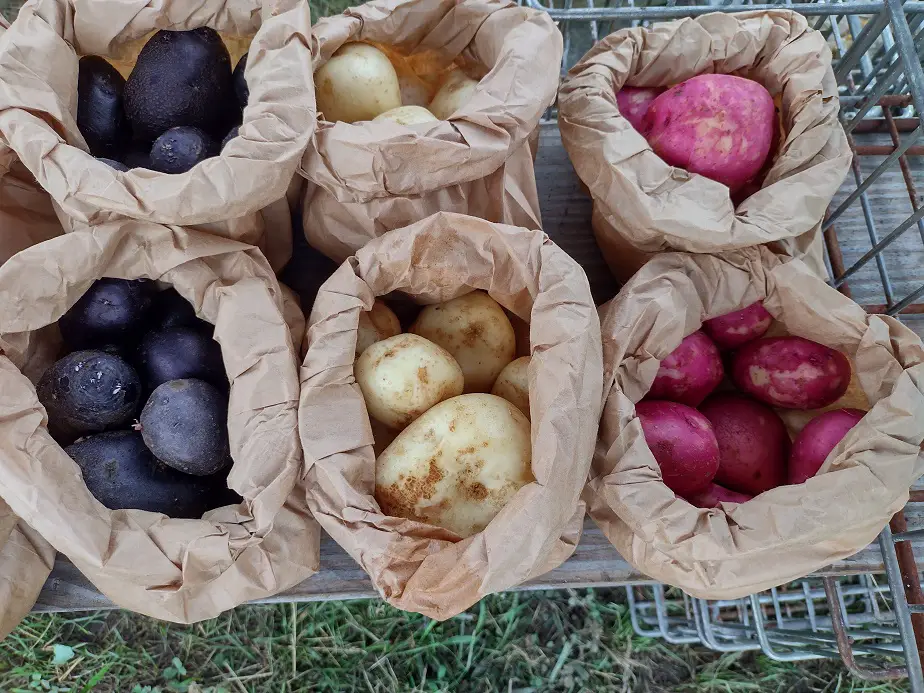I grow a few thousand pounds of potatoes every year, planted, fertilized, and harvested by hand.
The best fertilizer for potatoes is a low phosphorus, high potassium blend tailor-suited to your specific soil, ambient fertility, and weather conditions. A 10-10-10 type fertilizer is most common but has a poor fertility ratio for potatoes. Manures are also popular opttions, but are usually low in nitrogen.
Potatoes are tricky to fertilize properly and most so-called garden experts all share the same myths.
Choosing the Best Fertilizer For Potatoes
Before we get into the best fertilizers, let me say that you really need to do a simple soil test to know just what’s in your soil. I recommend the Lusterleaf 1601 Rapitest as a general starting point soil test. It’s a bit crude, but it works. For potatoes, I want to see high N, and High K. Phosphorus is almost irrelevant.
Now let’s dispel the most prevalent myth: “Potatoes need low-nitrogen and high-phosphorus because that helps root growth“. Golly is that all wrong. First off, all minerals are used throughout the plant. Secondly, potatoes actually need a lot of nitrogen and very little phosphorus.
Potatoes uptake about 0.25 ounces of nitrogen, .0015 ounces of phosphorus, and 0.35 ounces of potassium per plant. Most soils have enough phosphorus already for a crop of potatoes. That’s definitely not what people tell you at the garden center. In ratio, that’s an NPK of 20:3:30.
Most products at garden stores sold as “potato fertilizer” are low nitrogen, high potassium because that’s what people think the want. In reality, it’s a very limiting factor. Most “potato fertilizer” products are flat-out wrong!
Normal fertilizer applications have an NPK ratio of around 20:3:30 or 2:0:3. The University of Idaho says it’s rare for a potato field to ever need any added phosphorus because basically, all soils should already contain enough, especially within a crop rotation.
Most soils will already have at least a little N, P, and K. Test your soil then estimate how much of any lacking minerals you ought to add.
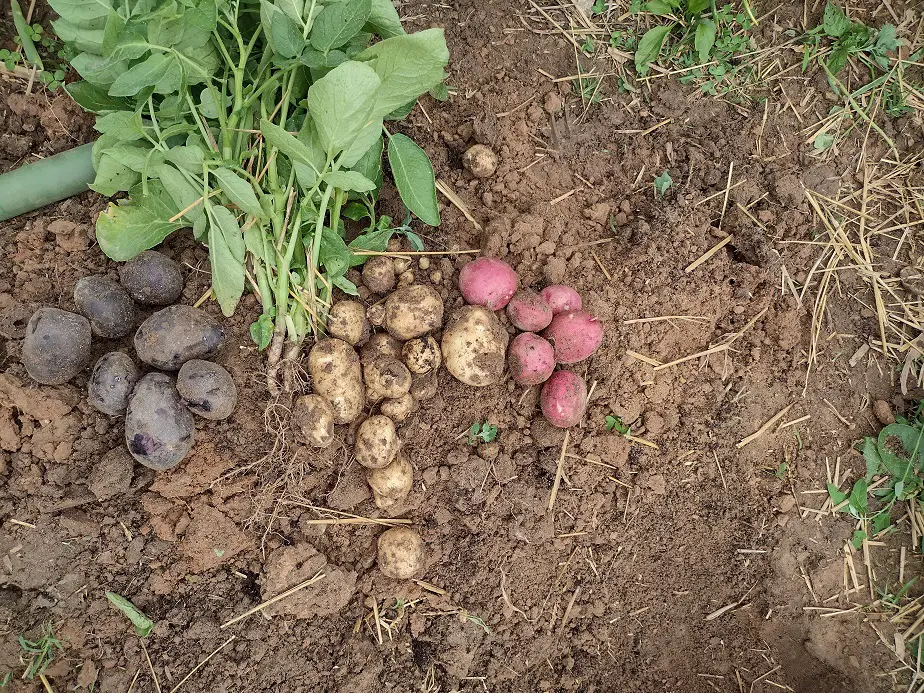
Best Fertilizer Products for Potatoes
My favorite fertilizer for potatoes is a mix of urea and agricultural potash, also called muriate of potash. be careful with them, they are strong and can hurt your soil if you’re not cautious. Generally, most soils are moderate to low in N and K every spring.
I like to add urea and potash at a rate of 200 pounds N and K per acre. For my soil, that’s usually adequate. Additional K will come through a heavy application of old manure that I do every April. If P is needed, the manure application will handle it. Here’s what that would look like in a garden.
| My potato fertilizer regimen heavy N and K, plus manure | Urea (46% N) | Potash (60% P) | Aged manure (approx 1% P, 1% K) |
| per acre | 434 pounds | 333 pounds | 63 cubic yards |
| per 1,000 square feet | 10 pounds | 7 pounds,11 oz | 1.5 cubic yards 6.5 decent wheelbarrows |
| per 100 square feet | 1 pound | 12 oz | 4 cubic feet 8, 5-gallon buckets |
I wrote a complete article on fertilizing with manure. Here’s a link to it.
To calculate how much of any particular fertilizer to apply, divide the desired application rate by the strength of your fertilizer, then scale the numbers to your garden or field size.
So, here I want the rate 200 pounds per acre N and K.
Urea is 46% N and I want 200 pounds per acre N application rate.
200 pounds per acre divided by 0.46 strength is 434 pounds urea per acre (about 43,000 square feet). My 2,500 square foot plot into an acre is 17.2, which is exactly how many pounds of urea I would apply.
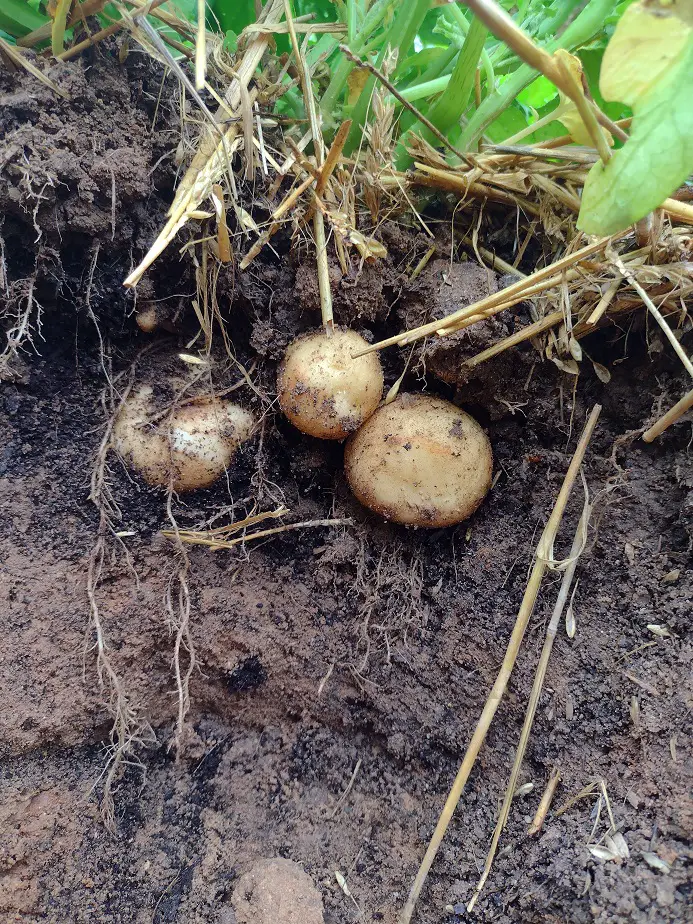
Now, you can certainly use a 10:10:10 type fertilizer or some other store-bought blend. If your soil tests low in phosphorus, something evenly balanced would be practical for a year. Just remember, that phosphorus isn’t really used much by plants and it stays in the soil for a long time.
Generally, I would prefer something that’s low in phosphorus or doesn’t have any at all. A lot of lawn fertilizers are decent that way, high in nitrogen and potassium, and low in phosphorus.
You can search online for a fertilizer with a smaller middle number, but I recommend buying them in-store. Shipping can be rough on a bag of fertilizers. Just be sure to test your soil and calculate about how much nutrients you will be adding.
Even with a pre-blended fertilizer, you need to know what you are adding. Too strong of any nutrient can have horrible effects on soil microbiology. You need to apply it properly and in a safe manner to avoid any problems like that.
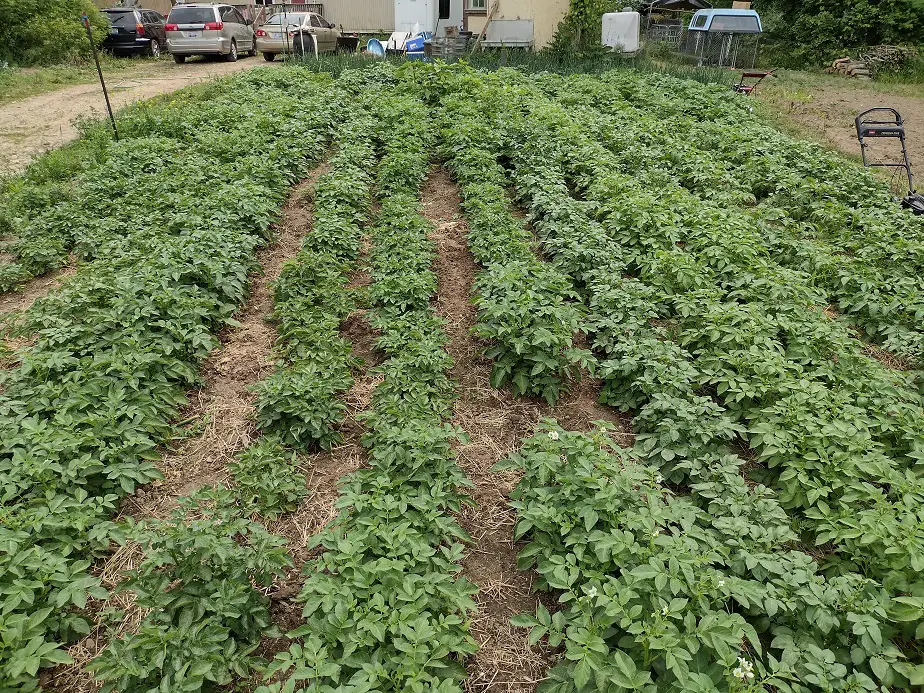
How to Fertilize Potatoes
Potatoes seek to use a lot of Nitrogen after emerging from the soil. They want to have a lot of early-available nitrogen and potassium, and a bit of phosphorus to grow large, bushy stems full of leaves.
After that, they want to have lessening nitrogen but the same availability of potassium and phosphorus to slow top-growth and push out a rush of blossoms.
After that, they prefer little nitrogen and seek a lot of potassium and magnesium for primarily bulking up tubers. The rest of the plant should not be growing at all during this time.
Apply all the needed nitrogen before the pants are 5 inches tall. I like to apply it in 4 intervals so I don’t put too much down at once. It’s better on the soil life that way. Applying 200 pounds per acre of N in one go kills a lot of worms and beneficial bacteria.
For spring planting fertilize about 2 weeks after planting, then again 1 and 2 weeks after they emerge. I want all the nitrogen and 3/4 of the potassium applied within these three applications. When I do apply it, I don’t just sprinkle it around.
I dissolve the needed amounts in water and spread the water evenly. Buckets or watering cans work great for this. It’s a bit of a hassle, but it’s way better on the soil this way, and it helps prevent nutrient loss. After applying, I’ll turn on the sprinklers a bit briefly, to help it soak in unless the soil is wet from spring rain.
When the plants are blooming, I like to give them my final fertilization with the potassium only, again, applied as dissolved in water. When fertilizing at this stage, it really, really helps to irrigate immediately after in order to rinse fertilizer off the plants and soak the nutrients into the soil.
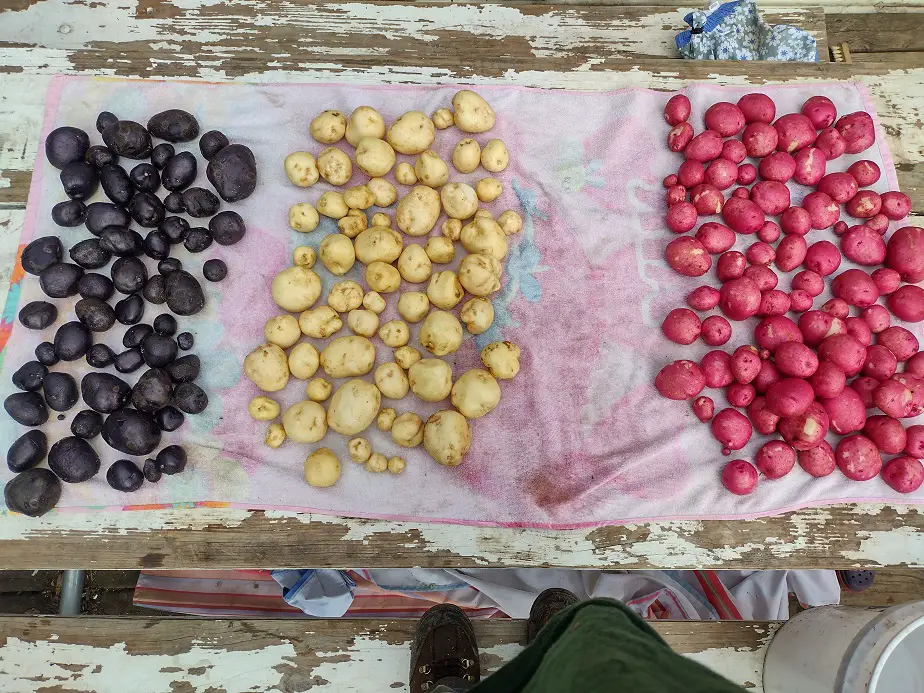
It’s important to not apply nitrogen after the plants are about ankle-high because that can make too much nitrogen in the next stage of plant development. Excessive nitrogen in the soil when the plant is wanting to enter the blossoming stage can actually keep the plant in the green-growth stage instead.
Soil that’s high in nitrogen at this stage will result in few or no potatoes by not allowing the plant to mature through the seasons as it naturally would. It messes with the plant’s growth and development hormones, keeping it in the juvenile stage.
Ideally, 75 percent of the nitrogen is gone by the blossoming stage. Since Nitrogen moves so easily in the soil, that’s rarely a problem as long as you don’t apply it too late. Most of it will be used up or washed away.
If you are adding compost or manure at any appreciable level, there should be little concern ever about other plant nutrients. Manure is usually the better of the two since it’s hard to get manure that’s low in any micronutrient. Compost is once in a while.
Heavy rains, sandy soils, and exxesive irrigation will reduce the fertility of your soil by washing away nutrients. Keep that in mind. Re-test your soil periodically throughout the deason to monitor the fertility and see compare that with your end of season yield to see if you used proper fertility applications.

Organic Fertilizer for Potatoes
Common fertilizers for organic potato production are alfalfa meal, fresh manure, high-fertility compost, pelletized poultry manure, and blood meal. Most organic fertilizers are low-strength and expensive. A well-amended soil with a high organic matter content helps to increase the function of less fertilizer.
The main problem with organic production is fertilizer cost. Without synthetic fertilizer, you can’t easily and cheaply make soil fertilie in a week. It takes much more material, much more effort, and much more time. It often takes more money too.
I do use some sythetic fertilizer. But, I could get my soil certified as organic tommorrow if I wanted to. The fertilizer itself isn’t a problem, since it’s the same exact chemiocals that I get from the compost and manures that we also use. The same chemicals are a natural result of organic mater breaking down.
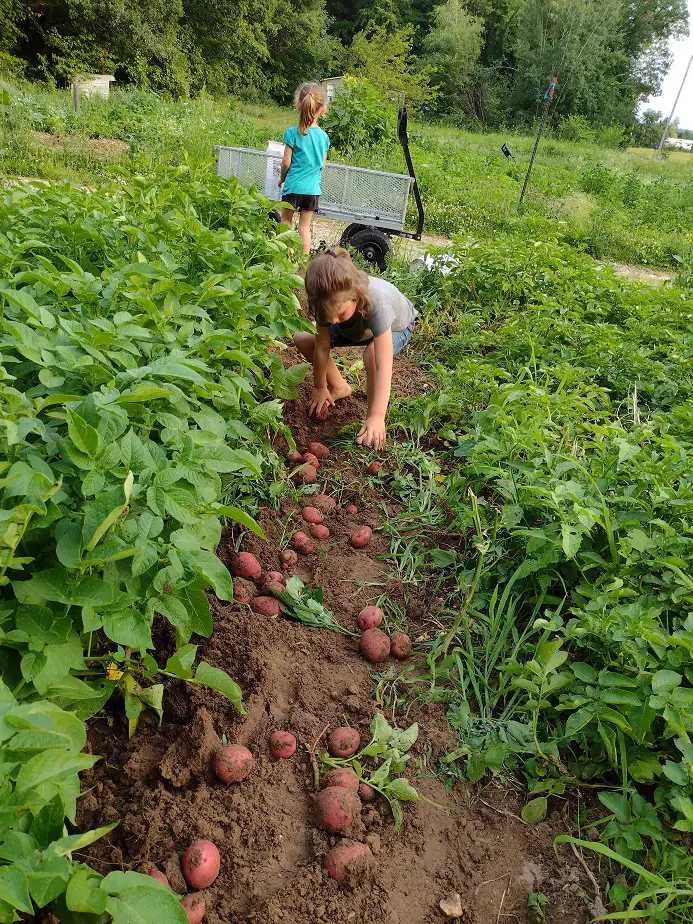
We use a lot of manure and that does help. Manure, if you want ot for fertilizer, needs to be frresh. older manure will have lost most of it’s nitrogen and won’t technically be a fertilizer any more. But, it will still help to enrich and condition yuour soil.
Pelletized poultry manure is neat. It has been dried while fresh so as to keep all it’s fertility. It’s not overly potent (usually an NPK of 4:2:2 or similar) so to takes a lot. But it’s a realy good fertilizer that contains all trace minerals, conditions the soil with organic matter, and feeds the soil microbes.
Alfalfa meal is more popular, but I truly believe that the pelletized poultry manure is far better as a fertilizer product.
Synthetic fertilizer isn’t the problem, unless you put it on so heavy that it kills the microbe life in the soil. And to be fair, you can do that easily. I am working towards building up my soil with compost, manure, and mulch so I can eventually get away fgrom fertilizer completely.
I’m also using my super duper biochar! That stuff is pretty cool. I keep my soil completely free from the problematic chemicals like herbicides and most pesticides and fungacides. We have no heavy metal problems, or other harmfull chemicals here. Just clean dirt.
A few Potato Facts
Potatoes need about 200-260 pounds of nitrogen, 30-40 pounds of phosphorus, and 300-400 pounds of potassium per acre for average commercial yields.
A field of potatoes is generally fertilized with about as much nitrogen and twice as much potassium per acre as a field of corn.
Potatoes are planted approx 20,00 plants per acre with spacing at 12-9 inches in rows, 24-36 inches between rows.
Nitrogen is needed up to the flowering stage, then dramatically reduced. Excessive nitrogen past this stage hinders tuber formation and severely impacts total yield.
Related Articles:

